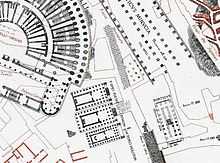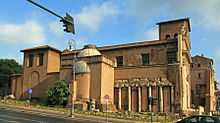Forum Holitorium
Coordinates: 41°53′28″N 12°28′48″E / 41.89111°N 12.48000°E

The Forum Holitorium ("Vegetable-sellers' market") was the site of a commercial marketplace (macellum)[1] for vegetables, herbs and oil in ancient Rome. It was "oddly located" outside the Porta Carmentalis in the Campus Martius, crowded between the Forum Boarium ("Cattle Market") and buildings location in the Circus Flaminius.[2]
Temples
Four Republican temples were part of the market complex. The two earliest were built during the First Punic War, the first a Temple of Janus vowed by Gaius Duilius following his victory in a naval battle at Mylae with the Carthaginians in 260 BC.[3] A Temple of Spes ("Hope") was built soon after by Aulus Atilius Calatinus.[4] A Temple of Juno Sospita was vowed in 197 BC and dedicated two years later. The Temple of Pietas that was dedicated in 181 was later removed and apparently relocated by Julius Caesar to begin construction on the Theater of Marcellus.[5]

Under the present church of San Nicola in Carcere are the ruins of three temples, standing side by side with the same orientation and facing the forum Holitorium. Besides some of marble of the later restorations, the architectural fragments are republican period work in travertine, tuff and peperino (previously decorated in stucco). The central and largest of these temples is Ionic, and is probably that of Spes. The northernmost temple is next in size and also Ionic, and is generally assumed to be the temple of Janus which is mentioned in the written sources, and is usually dated to about 90 BC. It is hexastyle, peripteral except at the back, and six of its columns, 0.70 meters in diameter, are still standing, built into the wall of the church. The southernmost temple is the smallest and Doric, and probably that of Juno Sospita.
These ruins are incorporated into and lie beneath the church (possibly after being incorporated into a prison, called carcere, which means prison). Remains of other temples lie under and around the Church of Sant'Omobono.
References
- ↑ Varro, De lingua latina 5.146.
- ↑ Lawrence Richardson, A New Topographical Dictionary of Ancient Rome (Johns Hopkins University Press, 1992), p. 165.
- ↑ Tacitus, Annales 2.49 http://latin.packhum.org/loc/1351/5/0#129.
- ↑ Cicero, De Legibus 2.28; Tacitus, Annales 2.49. http://latin.packhum.org/loc/1351/5/0#129
- ↑ Richardson, New Topographical Dictionary, p. 165.
External links
| Wikimedia Commons has media related to Forum Holitorium. |